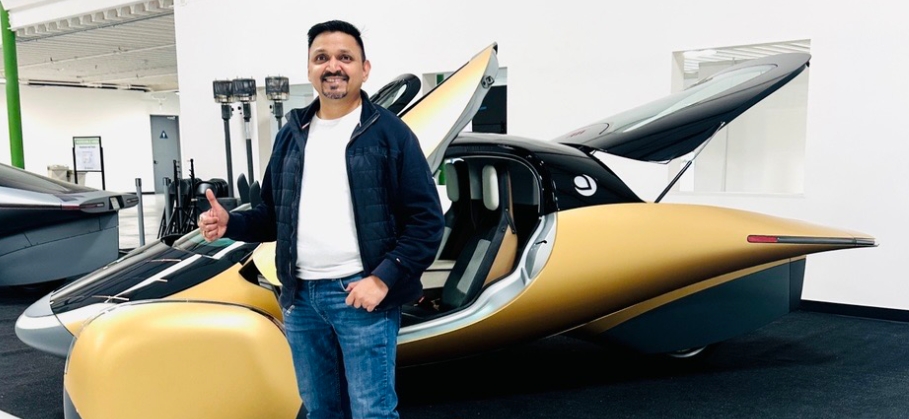The automotive industry, a realm steeped in over a century of convention, is at an inflection point. While electric vehicles are steadily gaining ground, much of their underlying design philosophy still echoes the gasoline-powered ancestors they seek to replace. But what if the very foundations of car building, from complexity to performance metrics, are flawed for the electric age? In the age of environmental urgency and energy rethinking, it’s no longer enough for a vehicle to just be electric. Design must justify its technology, and engineering must move beyond legacy architectures.
Shrikant Chopade, a Senior Engineering Manager at Aptera Motors, is among a select group of industry experts driving that shift. Having spent nearly two decades in the industry and working with OEM giants like Toyota and Honda, he now leads one of the boldest experiments in clean mobility: a solar-first electric vehicle that defies the norms of both form and function.
“The tipping point isn’t just range or cost anymore,” Shrikant explains. “It’s about whether your drivetrain reflects your design philosophy. Gasoline cars were built around heat. Solar EVs are built around efficiency.”
Aptera’s design philosophy, grounded in structural simplicity and material precision, is part of a larger trend among automakers reexamining every aspect of traditional design logic. While most mainstream EVs still mimic the form factors and production philosophies of combustion vehicles, emerging platforms like Aptera aim to challenge the assumption that complexity is necessary for performance.
A recent press coverage in Automotive World examined how Aptera’s design choices align with a growing industry shift toward structural efficiency and modular manufacturing, highlighting broader engineering trends rather than spotlighting a single company.
Fewer Parts, Greater Freedom
The industry is witnessing a quiet recalibration. From legacy OEMs to new entrants, engineering priorities are gravitating toward vehicle platforms that reduce component count, simplify tooling, and anticipate energy density constraints. Shrikant’s work echoes this industry-wide transition.
At Aptera, his team executed a structural consolidation strategy that emphasized carbon and glass SMC composites, materials prized for their stiffness-to-weight ratios and thermal stability. This effort contributed to a vehicle efficiency rating of over 10 miles per kilowatt-hour, significantly outperforming the industry average of 4–5 miles per kWh. This isn’t just technical progress, it is financial and environmental leverage, directly reducing charging frequency and material usage.
“Reducing parts isn’t just about cost or speed,” Shrikant explains. “It’s about clarity in design intent. When the structure supports the function directly, your tolerance margins improve, your energy transfer becomes more predictable, and your failure modes become easier to manage.”
This systems-first mindset extends into simulation. In his academic paper, “Architecting Scalable Intelligence for High-Throughput Autonomous Systems”, Shrikant outlines how generative AI can model component interactions at scale, supporting better thermal predictions, failure response, and energy channeling within composite body systems. It’s a step toward closing the feedback loop between hardware and design intelligence.
A New Kind of Industry Recognition
EV innovation isn’t measured solely in kilowatts or range anymore. Sophistication now lies in structural intelligence, lifecycle cost-efficiency, and platform scalability. A 2024 McKinsey report found that over 60% of automotive executives rank modularity and manufacturability among the top criteria for platform investment, well above performance specs or software features.
CES 2025 echoed this sentiment. Platforms like Aptera attracted industry attention not for flashy zero-to-sixty figures, but for their strategic rethinking of vehicle architecture. Their success at CES was not a media spectacle, it was a marker of how quickly the definition of meaningful innovation is changing.
Shrikant’s contribution to Aptera’s closure systems fits squarely within this shift. He led a reengineering effort that optimized bonding interfaces, tested seal performance under long-term fatigue loads, and reduced reliance on welds through pre-validated modular geometry. The net outcome? A 30% reduction in assembly time, with improved thermal tolerance and maintenance access. While the outcomes earned internal recognition, the more telling achievement is methodological: a design approach that sees structural points not just as mechanical links, but as opportunities for intelligence, efficiency, and repeatability.
“The industry doesn’t need more complexity,” Shrikant says. “It needs smarter simplicity. Designs that stay resilient, even when the rest of the system is under pressure.”
Designing Systems That Anticipate, Not Just Adapt
Much of the EV sector’s future will depend on how well vehicles are engineered to handle unpredictability, whether it is supply chain volatility, repairability challenges, or shifts in regulatory requirements. Engineers are now expected to build with foresight, not just flexibility.
Shrikant’s work in developing closure systems didn’t end at design validation, it extended into homologation planning, supplier tooling alignment, and downstream maintenance. The goal was not to hit a single set of test conditions but to perform reliably across certification regimes, tooling inconsistencies, and service disruptions.
That approach is now finding broader application. In a 2025 Deloitte survey, 72% of EV manufacturers ranked resilience in supply and service ecosystems as the top determinant for platform longevity. Shrikant’s system-level thinking, refined through years of working across OEMs like Toyota, Honda, and Tata Motors, directly addresses this challenge.
“Predictability isn’t just about test results,” Shrikant says. “It’s about how consistently your system performs when the environment around it doesn’t.”
It’s why engineers with cross-domain fluency, those who can marry CAE models with supplier constraints, and crash compliance with design intuition, are playing a more influential role in defining product success.
From Exception to Expectation
The EV industry is no longer content with incremental gains. Energy systems are expected to support onboard intelligence, lightweight frames must be serviceable and durable, and every design decision must anticipate lifecycle realities.
Shrikant’s trajectory mirrors this industry maturity. From traditional platforms to composite-integrated EVs, his design logic is built around engineering foresight. As a 2025 Globee Awards Judge for Technology, he now evaluates global platforms based not just on novelty, but on execution quality, how scalable, maintainable, and structurally rational the design really is.
“The conversation has shifted,” he says. “Today it is not just: can you build it? It’s: should you build it this way?”
Gasoline cars may not vanish overnight, but their design logic is losing its grip. In its place, engineers like Shrikant are sketching blueprints for machines that are lighter, cleaner, and far more aligned with the mechanical logic of the electric age.



































